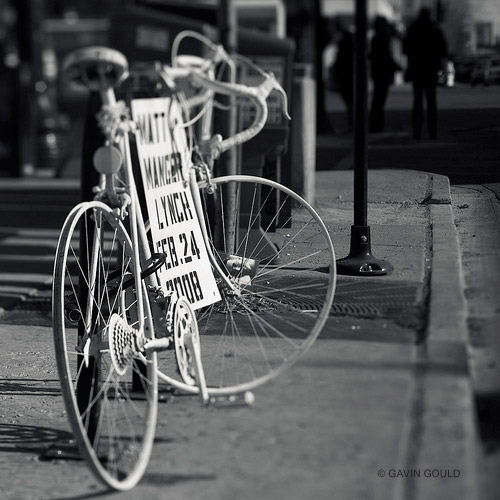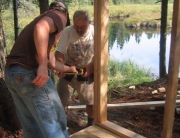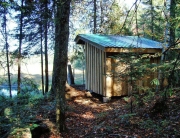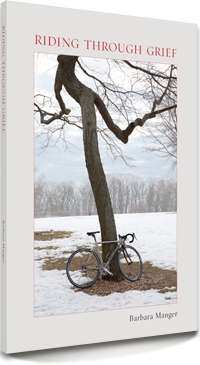Across Chicago, streams of bicyclists pay tribute to ghostly white bikes, roadside memorials for those among them who have died in car accidents
By: Robert Mitchum | Tribune reporter. Published: May 22, 2008
In the shadows beneath the overpass that runs above Logan Boulevard and Western Avenue, a spray-painted white bike is chained to a streetlight pole a few feet away from where Tyler Fabeck was struck and killed by a car last month.
The bicycle stands silent sentry on the southeast corner of the busy intersection, flashing brightly in cars’ headlights as they pass. Known as a “ghost bike,” it was assembled by friends and family of Fabeck and is the latest addition to at least eight such monuments left by Chicago cyclists where they lost one of their own.
“In the biking community, we kind of look at it as the equivalent of a cross on the side of the road,” said Joshua Horsley, 29, who helped build the bike last weekend. “For friends that knew he rode all the time, even if they don’t ride themselves, they would understand. They would find this fitting.”
Fabeck’s death, combined with the deaths of three other young cyclists in Chicago in the last eight months, has shaken the city’s rapidly growing cycling community and raised interest in grass-roots rituals like the ghost bikes and memorial rides.
On Wednesday night, about 200 people visited four intersections where fatal crashes occurred as part of the Chicago Ride of Silence, the local version of a yearly tradition now observed by cyclists in cities around the world.
“Unfortunately, as there is more cycling on the roads, there’s an increase in cycling and vehicular confrontations,” said Elizabeth Adamczyk, organizer of the Ride of Silence. “We’ve had a few tragedies, especially the in past year, and that has really called attention to the Chicago ride.”
In addition to Fabeck, 22, the deaths also include Amanda Annis, 24, and Blanca Ocasio, 19, who were killed six months apart at the same Logan Square intersection, and Matthew Manger-Lynch, 29, who was killed at Lincoln Avenue and Irving Park Road during a February street bike race.
Wednesday’s memorial ride visited those three sites before ending at Western Avenue and Cortez Street, where the first ghost bike was installed in 2006 for Isai Medina, 50, the victim of a hit-and-run accident.
The concept originated in St. Louis in 2002, when Patrick Van Der Tuin, a bike shop worker, witnessed a car swerve into a bike lane and severely injure a young woman. In response, Van Der Tuin took a junk bike, smashed it with a sledgehammer, spray-painted it white and installed it at the scene of the crash.
“I wanted it to be as shocking as possible,” Van Der Tuin said. “I had no problem completely wrecking the front end of the bike to get the point across.”
Though the strong response from the local cycling community inspired Van Der Tuin and friends to install dozens more bikes, he was surprised to see his idea taken up by cyclists from Austin, Texas, to Vienna.
“The thing is, that imagery can be used in just about anybody’s city for very, very similar issues: for people that are killed or people that are hit,” he said.
On Sunday, people who knew Fabeck gathered behind West Town Bikes, a workshop in Humboldt Park, to build their friend’s ghost bike.
Starting with a junked frame, several friends and Tyler’s brother Jason took turns stripping the handlebars, welding on wheels and pedals and spray-painting the final, assembled product.
After adding a memorial sign with Fabeck’s name, dates of birth and death and the phrase “Never Forget,” the bike was chained Monday night to a pole on Western Avenue. Howard Kaplan, who helps coordinate the building of ghost bikes with the families and friends of crash victims, said that some bikes are removed within days, either by thieves or city workers, while some survive for months or years.
For the builders of Fabeck’s ghost bike, the silent monument would send many messages. Jason Fabeck said he hoped his brother’s memorial would remind people to bike safely, while Kaplan saw the tragedy both as another sad reminder of Americans’ over-reliance on cars and an opportunity for the cycling community to come together.
“It gives victims a voice, but it also helps the rest of us feel like we’re connected,” Kaplan said. “You don’t have to feel like every time a car passes you too close that you’re alone.”





